Fayum Mummy Portraits: The Oldest Modernist Paintings

W.M. Flinders Petrie, a British archaeologist has discovered the Fayum in the years between 1887 and 1889. Fayum is a sprawling oasis region 150 miles south of Alexandria wherein he excavated a vast cemetery from the first and second centuries A.D., when imperial Rome ruled Egypt, he found scores of exquisite portraits executed on wood panels by anonymous artists, each one associated with a mummified body. Petrie eventually uncovered 150.
Mummy portraits have been found across Egypt, but are most common in the Faiyum Basin, particularly from Hawara and Antinoopolis, hence the common name. “Faiyum Portraits” is generally thought of as a stylistic, rather than a geographic, description. While painted Cartonnage mummy cases date back to pharaonic times, the Faiyum mummy portraits were an innovation dating to the Coptic period on time of the Roman occupation of Egypt.
Most of the preserved mummy portraits were painted on boards or panels, made from different imported hardwoods, including oak, lime, sycamore, cedar, cypress, fig, and citrus. The wood was made smooth and cut into thin rectangular panels. The finished panels were set into layers of wrapping that enclosed the body, and were surrounded by bands of cloth giving the effect of a window-like opening through which the face of the deceased could be seen. Portraits were sometimes painted directly onto the canvas or rags of the mummy wrapping (cartonnage painting).
By now, nearly 1,000 Fayum paintings exist in collections in Egypt and at the Louvre, the British and Petrie museums in London, the Metropolitan and Brooklyn museums, the Getty in California and elsewhere.

For decades, the portraits lingered in a sort of classification limbo, considered Egyptian by Greco-Roman scholars and Greco-Roman by Egyptians. But scholars increasingly appreciate the startlingly penetrating works, and are even studying them with noninvasive high-tech tools.
At the Ny Carlsberg Glyptotek museum in Copenhagen, scientists recently used luminescence digital imaging to analyze one portrait of a woman. They documented extensive use of Egyptian blue, a copper-containing synthetic pigment, around the eyes, nose and mouth, perhaps to create shading, and mixed with red elsewhere on the skin, perhaps to enhance the illusion of flesh.
Stephen Quirke, an Egyptologist at the Petrie museum and a contributor to the museum’s 2007 catalog Living Images, says the Fayum paintings may be equated with those of an old master—only they’re about 1,500 years older.
Doxiadis has a similar view, saying the works’ artistic merit suggests that “the greats of the Renaissance and post-Renaissance, such as Titian and Rembrandt, had great predecessors in the ancient world.”
Image source: commons.wikimedia.org




